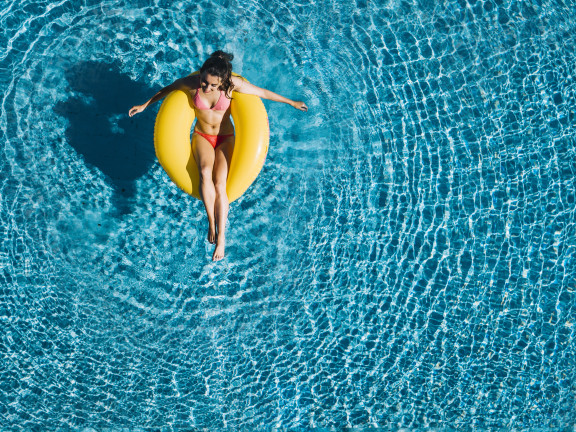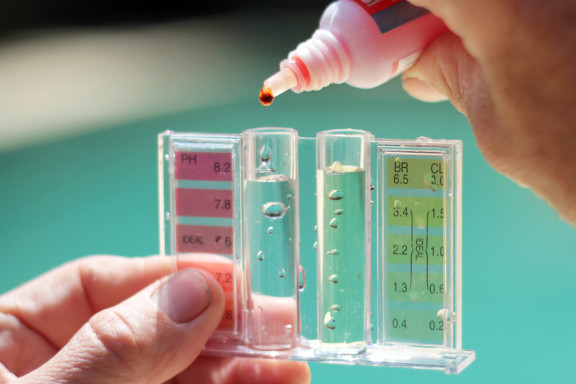Chlorine-free pools: how do they work?
Pools can be treated without chlorine, even though it is certainly the most common method used to disinfect pool water. This choice generally enables you to improve swimming comfort, reduce maintenance, and even to change for a more ecological solution.
Why choose chlorine-free treatment?
In the end, a pool with an electrolyser is not very salty. Its water does not resemble seawater and it is in fact chlorine that performs the task of water purification. So, how does it work?
How can salt be transformed into chlorine?
A salt pool uses two elements to create chlorine: sodium chloride and electrical energy. Indeed, when it comes into contact with electricity, salt oxidises and transforms into sodium hypochlorite, or natural chlorine, which becomes active chlorine on contact with water and destroys algae and bacteria.
What is the role of a pool salt electrolyser?
An electrolyser is a device that enables salt to transform into chlorine. It consists of electrodes that create an electrical current that comes into contact with the sodium.
Once the chlorine is in the pool, it is exposed to solar UV rays and returns to the sodium state to return to the electrolyser. Thus, this method follows a perpetual cycle that automatically renews itself.
Chlorine-free pools: what treatments are available?
Chlorine-free treatment does not necessarily mean natural treatment. Although some solutions are indeed more eco-friendly, others simply use different chemicals. In any case, these methods can generally be applied to in-ground pools as well as above-ground or self-standing pools.
Active oxygen
A natural treatment that is ideal for small pools or for a shock treatment.
The principle
Active oxygen comes in the form of tablets, granules, powder or liquid. Its natural molecules act on bacteria and destroy them. Its action is powerful but short-lived: it is therefore necessary to repeat the treatment often. That is why this solution is more often recommended for small pools. Over 40 m³, it should be combined with another disinfectant to prolong its action. Active oxygen is also very sensitive to variations in pH and temperature, so you must be vigilant to maintain good water balance.
Installation
Active oxygen is a costly treatment because, due to its short duration, it is necessary to use a large quantity and frequently repeat the operation. Ideally, you should be equipped with a dosing pump or an automatic regulator, and don't forget the additional treatment for large pools.
Bromine pools
A chemical treatment that is similar to chlorine, but odourless and non-irritating.
The principle
Available in the form of tablets or granules, bromine disinfects the pool in a similar way to chlorine. In addition to being non-irritating and not having an unpleasant odour, it has the additional advantage of being effective even in warm water. Therefore, bromine is a good solution for hot tubs and heated pools. It is also less sensitive to pH variations and shows better resistance to UV rays, which facilitates pool maintenance.
Installation
Granules are used directly in the skimmers, while tablets need a brominator. It is strongly recommended to use a brominator for more effective treatment. Connected to the filtration system, a brominator enables the continuous and progressive release of the product into the pool.
Salt electrolysis
Natural chlorine with no need to store toxic products in your home? It's possible with salt electrolysis.
The principle
In pools equipped with a salt electrolysis system, electric energy transforms sodium chloride into natural chlorine, which in turn becomes active chlorine when it comes into contact with pool water, in a perpetual cycle. It is not necessary to add salt very frequently, which facilitates maintenance, but be careful: salt treatment is highly sensitive to variations in pH, which has to be closely monitored. This method is also more eco-friendly: even if a chemical process takes place during electrolysis, you will not use any toxic products. Indeed, the chlorine produced by salt electrolysis is not the same as chemical chlorine, so you will not have any problems with odours and skin irritation.
The installation
The treatment itself is not very expensive, because it only consists of salt. However, salt pools require the installation of an electrolyser in the filtration system. This device contains electrodes that must be replaced frequently.

PHMB
Another chemical solution, PHMB is odourless and non-irritating.
The principle
PHMB, for polyhexamethylene biguanide, is another highly effective alternative to chlorine. It is also a chemical product, but odourless. Its main advantage is its stability – it is not sensitive to UV rays, nor to variations in pH. It also acts as a flocculant and thus limits the number of products used.
The installation
It comes in liquid or tablet form and must be completed with an algaecide, because it has no action against the development of algae. PHMB is placed directly in the skimmers and is thus released into the pool.
UV rays
Ultra-violet light, another solution to avoid chemical treatment.
The principle
UV rays act directly on bacteria and micro-organisms. A UV lamp can be used to purify pool water and to obtain optimal bathing comfort. You thus have a solution that is both non-irritating and eco-friendly. UV treatment also offers you the comfort of eliminating the use of maintenance products.
The installation
In order to treat water, a UV lamp must be installed in the filtration circuit. The disadvantage of this method: the lamp has a limited life cycle (between 5,000 and 15,000 hours of use) and must therefore be replaced regularly.
The natural pool
A unique treatment method: the natural pool reproduces an entire eco-system.
The principle
A biological pool recreates a natural ecosystem with plants, entirely eliminating the need for disinfectant products. The pool water circulates between a bathing area, a lagooning area and a regeneration area. The aquatic plants and algae present in the lagooning area filter and clean the water.
The installation
It is a very eco-friendly solution, but one that requires a much greater investment, both to create the ecosystem and for maintenance. It is also necessary to wait until the ecosystem develops before bathing. And finally, even if this solution is eco-friendly, it nevertheless requires a high level of electricity consumption to operate the pump and maintain the water circulation between the different areas.
Chlorine-free pool maintenance
A chlorine-free pool requires maintenance adapted to the chosen treatment. As a general rule, you will have to pay attention to the following four points to maintain a clean pool.
Clean the pool
The combination of regular cleaning with a disinfectant will help you maintain clean water. You should purchase a pool net and vacuum cleaner to prevent dirt from accumulating at the surface of the water or at the bottom of the pool.
Check the pH and the disinfectant
The pH plays an important role in pool maintenance for both chlorine and chlorine-free pools. Weekly checks will ensure you maintain well-balanced water. Also check the disinfectant rate regularly, depending on the method chosen, to ensure that its action remains effective.
Complete the treatment with certain maintenance products
Depending on the treatment system for your chlorine-free pool, you may need to use additional products, including an algaecide to combat the appearance of algae, or a flocculant to eliminate smaller particles of dirt. In some cases, an anti-limescale treatment may also be necessary.
Cover your pool
The final step to adopt for the maintenance of your chlorine-free pool: install a cover to protect the pool, reduce the cleaning time necessary and to prevent rainwater from disturbing the pH balance.

What is the best treatment for your pool?
Chlorine may have a poor reputation, because we are often well informed of its irritating nature and are aware of its odour, which we may not appreciate. Does that mean we should absolutely avoid chlorine and that there is an ideal treatment for your pool? Not really.
No one pool treatment is really better than another. All solutions are very effective and each has its advantages and disadvantages. The choice of the best treatment is entirely subjective and depends on:
– Your personal constraints: a chlorine allergy, for example, will necessarily force you to choose an alternative;
– The time you can and wish to devote to the maintenance of your pool;
– The budget that you can allocate to water treatment;
– Your desire to use more eco-friendly products.
It is therefore quite possible to avoid chlorine in your pool and numerous solutions are available to you. You will often have to install specific equipment and possibly increase your pool maintenance budget. Be careful if you wish to change from one treatment to another: some methods are not at all compatible with chlorine and the change must be made with care.


